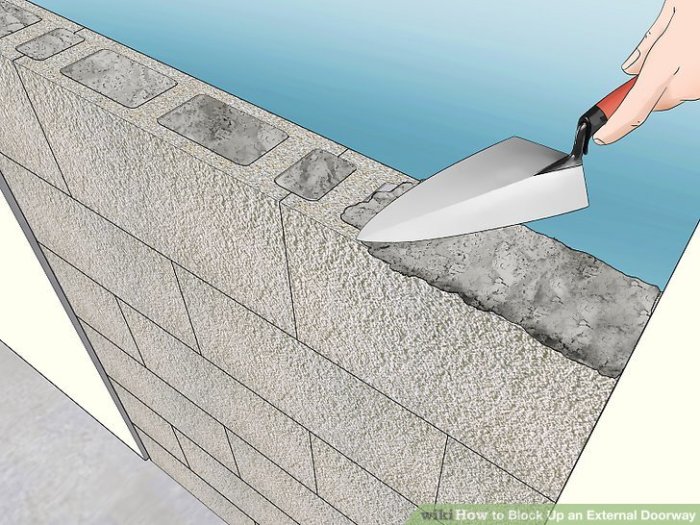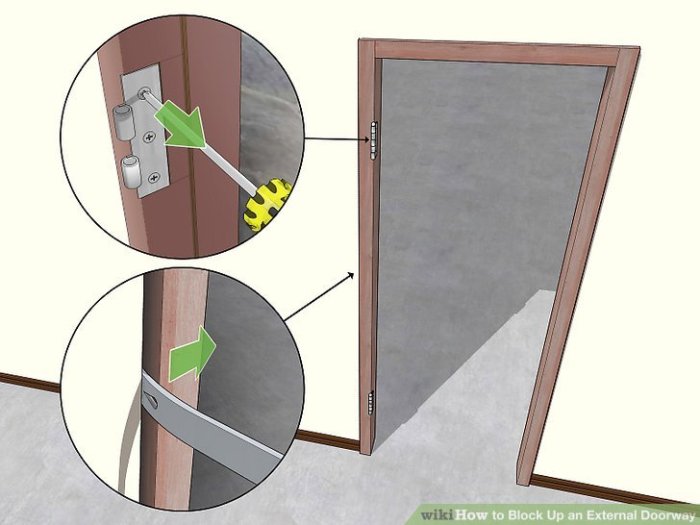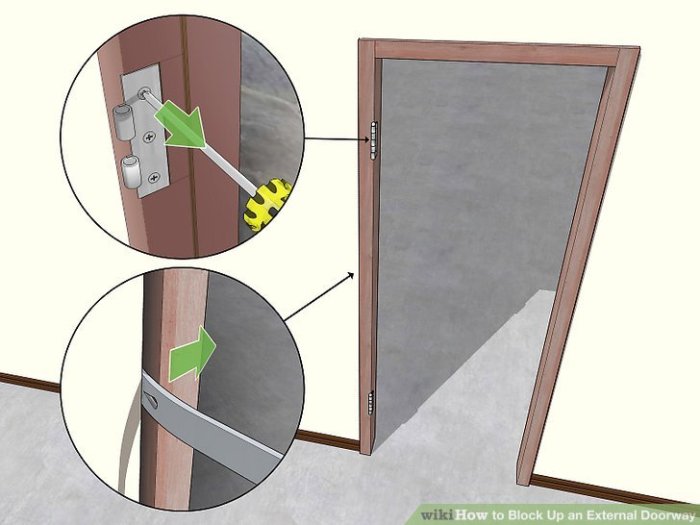Block Up an External Doorway: This guide explores various methods for securing an external doorway, from temporary barricades to permanent solutions. We’ll delve into security considerations, emergency preparedness, and the crucial balance between safety and accessibility. Whether you need to secure your home or prepare for an emergency, this comprehensive guide will provide you with the knowledge and tools to create effective and safe blockades.
From heavy furniture to makeshift structures, we’ll examine different materials and their effectiveness in blocking an external doorway. We’ll also discuss the importance of considering environmental factors, like weather conditions, and how to adapt your blocking methods accordingly. This guide will also cover the critical aspects of safety and accessibility, ensuring that your blockade doesn’t compromise the well-being of others.
Methods of Blocking an External Doorway
Blocking an external doorway requires careful consideration of both effectiveness and safety. Improper blocking can be ineffective, potentially compromising security or even leading to injury. This section details various methods, materials, and important factors to consider when choosing a blocking strategy.
Physical Barriers
A crucial aspect of blocking a doorway is utilizing readily available physical barriers. Furniture, heavy objects, or even makeshift structures can create a formidable obstacle. The key is to select materials that provide substantial resistance to forced entry.
- Furniture: Solid pieces of furniture, such as sturdy tables, desks, or even heavy bookcases, can be strategically placed to block the doorway. However, consider the weight and stability of the furniture; a wobbly or easily moved object won’t be effective. Heavy, solid-wood furniture is generally more suitable than lightweight, modern designs.
- Objects: Heavy objects like large boxes, bags of sand, or even stacked bricks can create significant resistance. The crucial factor is the weight and the stability of the object in relation to the force it will have to withstand. Ensure the object is stable and won’t shift or topple easily.
- Improvised Barricades: If other materials are unavailable, makeshift barricades can be constructed using readily available materials like stacked lumber, reinforced cardboard, or even sandbags. The key to success with improvised barricades is ensuring they are robust enough to withstand the anticipated pressure.
Materials for Blocking
The choice of materials significantly impacts the effectiveness and safety of the blocking method. Different materials offer varying levels of resistance and stability.
Blocking up an external doorway can be a surprisingly satisfying DIY project. It’s a great way to enhance security and keep unwanted guests out, much like the renewed energy a band like the Smashing Pumpkins might bring back to their fans, especially with Jimmy Chamberlin rejoining the band! jimmy chamberlin rejoining the smashing pumpkins. Ultimately, a properly sealed external doorway adds a layer of peace of mind and is a smart home improvement, whether you’re prepping for a new album or just looking to keep things secure.
- Heavy Boxes: Full, heavy boxes, particularly those containing substantial items, can create a strong barrier. Ensure the boxes are placed firmly against the doorway and are not easily dislodged.
- Stacked Books: While seemingly simple, a large stack of heavy books can provide a surprising degree of resistance, especially if stacked tightly and supported. However, this method is less effective against significant force.
- Other Materials: Materials like bricks, cinder blocks, or even bags of sand, when strategically placed, can create robust barriers. The key to effectiveness is the weight and the stability of the material.
Effectiveness and Safety Comparison
Different blocking methods vary in their effectiveness and safety. A well-placed, heavy piece of furniture can provide a secure barrier, but a flimsy object might easily be moved.
| Blocking Method | Pros | Cons |
|---|---|---|
| Heavy Furniture | Relatively secure, stable | May not be easily movable, potentially blocking access to the area. |
| Heavy Objects (Boxes, etc.) | Readily available, relatively inexpensive | May shift or topple if not properly secured |
| Improvised Barricades | Potentially adaptable to various situations | May not be as strong or durable as other methods |
| Stacked Books | Relatively inexpensive, readily available | Least effective against significant force, easily dislodged. |
Security Considerations: Block Up An External Doorway

Blocking an external doorway, while a temporary measure, demands careful consideration of security. A poorly executed block can compromise safety and leave your property vulnerable to unwanted entry. This section delves into the importance of security, potential risks, and factors to consider when selecting the right blocking method.Understanding the security implications of blocking an external doorway is crucial.
A poorly secured blockage can be easily bypassed, potentially leading to unwanted intrusions. Choosing the right method is vital to ensuring the safety of your property and its inhabitants.
Importance of Security in Blocking
Proper blocking methods are paramount for deterring potential intruders. A robust blockage, designed to withstand attempts at forced entry, significantly increases the difficulty for unauthorized access. This discourages opportunistic criminals and reinforces the security posture of the property.
Potential Risks of Inadequate Blocking
Inadequate blocking measures can create significant security vulnerabilities. Improvised or weak blockades can be easily overcome by determined individuals. This can result in property damage, theft, or even personal harm. Criminals may view a poorly secured blockage as an easy target, potentially increasing the risk of a successful intrusion.
Factors to Consider for Different Security Levels
Several factors influence the choice of blocking method, including the expected level of security required and the resources available. Assessing the potential threats and the specific security needs of the property is critical. Consider the type of intruders you might encounter and the resources available for reinforcement. The level of security desired should be aligned with the potential threats and resources.
Security Level vs. Blocking Method
| Security Level | Description | Appropriate Blocking Method |
|---|---|---|
| Low | Minimal security requirements, deterring casual intruders. | Heavy-duty cardboard boxes, stacked furniture, or strategically placed large potted plants. |
| Medium | Significant security needs; deterring opportunistic criminals. | Reinforced wooden planks, secured with heavy-duty hardware. Consider adding a layer of metal or reinforced materials for enhanced resistance. |
| High | Maximum security; preventing entry by determined individuals or organized groups. | Heavy-duty steel plates, reinforced concrete barriers, or specialized security shutters. These require professional installation and potentially a reinforced framework. |
Temporary vs. Permanent Blocks
Blocking an external doorway requires careful consideration of the desired level of security and the timeframe for the blockage. Choosing between temporary and permanent solutions hinges on the specific needs and circumstances. Understanding the advantages and disadvantages of each approach is crucial for making an informed decision.Temporary solutions offer flexibility, while permanent solutions provide long-term security. However, temporary measures may not be as robust and may require more frequent maintenance or replacement.
Temporary Blocking Solutions
Temporary blocking methods are ideal for short-term security needs, such as during construction or for events. They provide a quick and relatively inexpensive way to secure an area. These methods can be easily removed or modified when no longer needed.
- Barricades: Barricades, including simple wooden boards or metal barriers, are a common temporary solution. They are relatively inexpensive and can be moved or adjusted as required. However, their effectiveness depends on the strength of the materials and the type of barricade. For instance, a flimsy wooden board may be easily pushed over, while a sturdy metal barricade may provide better security.
Blocking up an external doorway is a surprisingly effective security measure, especially if you’re concerned about potential intruders. Thinking about the recent news about demon eyes live in NYC, it makes you wonder if there are more sinister things lurking than just regular neighborhood problems. Maybe, just maybe, blocking that doorway is the only way to keep those eyes away from your home.
It’s a simple yet powerful deterrent. demon eyes live in nyc definitely got me thinking about the things we might not see coming. Regardless, securing your home is a priority, and a blocked doorway is a good first step.
Placement and stability are critical factors to consider when using barricades.
- Bolstered Doors: Additional support, like strategically placed heavy objects, can temporarily block a doorway. This method can be effective but is not ideal for long-term use. Care should be taken to ensure the weight is evenly distributed and that the objects do not damage the structure. For example, heavy furniture pieces or sandbags can be used for bolstering.
However, such methods might cause structural damage or be unsafe if not implemented correctly.
- Security Screens: Security screens or mesh panels can provide a barrier to prevent unauthorized entry. They are relatively inexpensive and easy to install, but may not be as effective as other methods in deterring determined intruders. Security screens are most suitable for areas where visual deterrence is sufficient, such as temporary events or areas with minimal risk of forced entry.
Permanent Blocking Solutions
Permanent blocking methods offer a more robust and lasting solution for security needs. These solutions require more planning and investment, but they provide a reliable and enduring level of security.
- Reinforced Doorways: Reinforcing existing doorways with reinforced materials or new, more secure doors is a permanent solution. This significantly enhances security and can deter potential intruders. Examples include installing reinforced steel doors or adding metal plates to existing wooden doors. The cost and complexity of installation vary significantly depending on the material and type of reinforcement.
- Wall Extensions: Constructing a wall extension to block the doorway is a permanent solution that effectively eliminates access. This is a significant undertaking, requiring substantial planning, materials, and labor. It’s suitable for situations where permanent closure is essential, such as in commercial spaces or high-security areas.
- Security Gates: Installing security gates can provide a permanent barrier. They come in various designs, from simple metal gates to elaborate automated systems. Their cost and complexity depend on the gate’s size, features, and automation. They are suitable for situations requiring controlled access and robust security, like parking garages or warehouses.
Comparison of Temporary and Permanent Blocking Methods
The following table summarizes the key differences between temporary and permanent blocking methods, considering cost, time, and effectiveness.
| Characteristic | Temporary Blocking | Permanent Blocking |
|---|---|---|
| Cost | Generally lower | Generally higher |
| Time | Faster installation | Slower installation |
| Effectiveness | Variable, depending on the method | Higher effectiveness, generally |
| Maintenance | Potentially higher | Potentially lower |
| Flexibility | High | Low |
Emergency Situations

Blocking an external doorway can be a crucial life-saving measure during emergencies. From natural disasters to violent situations, securing access points can prevent further harm and allow for controlled evacuation or response. Understanding the procedures and considerations for blocking in these situations is vital for preparedness and effective action.A properly blocked doorway can buy precious time during an emergency, allowing for evacuation, rescue operations, or securing the area.
It can be a crucial element in safeguarding lives and property.
Critical Emergency Scenarios, Block Up an External Doorway
Blocking an external doorway is critical in a wide range of emergency situations. Examples include active shooter situations, natural disasters like earthquakes or floods, and even medical emergencies where rapid access is restricted. In each scenario, the ability to control access to the building can significantly impact safety and security. Blocking a doorway acts as a temporary barrier, preventing unauthorized entry or exit, and maintaining a safe perimeter.
Procedures for Secure Blocking
Creating a secure block in an emergency situation requires careful planning and execution. The specific method depends on the available materials and the nature of the emergency. Use readily available materials, such as heavy furniture, barricades, or even improvised methods using readily available items. Consider the type of doorway and the potential force that might need to be resisted.
For instance, a sturdy table might suffice for a minor incident, but a more substantial barricade might be necessary for a larger-scale emergency. A critical factor is the speed of implementation. Quick action is paramount. Thorough planning and practice beforehand can make a significant difference in response time.
Emergency Considerations
- Assessment of the situation: Before blocking, accurately assess the situation. Is it a natural disaster, an active shooter event, or a medical emergency? The nature of the event dictates the appropriate response and blocking method. Understanding the type of emergency allows for a targeted approach, maximizing effectiveness.
- Availability of materials: Identify readily available materials for blocking. This could include furniture, heavy objects, or even improvised barricades. A well-stocked emergency kit can contain critical materials for quick implementation.
- Safety of personnel: Prioritize the safety of those involved in the blocking process. Ensure everyone is aware of potential hazards and follows proper safety procedures. For instance, if there is a fire, blocking should only be done when the safety of the individuals involved is ensured.
- Time constraints: Emergency situations often have strict time constraints. Blocking should be implemented quickly and efficiently. Swift action is crucial for preventing further harm or allowing for quick response.
- Security considerations: Ensure the block is robust enough to deter unauthorized entry or exit. The type of block and materials should be sufficient to withstand potential pressure.
Accessibility and Safety
Blocking an external doorway, while crucial for security, must never compromise the safety and accessibility of others, particularly during emergencies. Prioritizing safety involves careful planning and execution, ensuring that any block is easily removable in critical situations. This section details the importance of maintaining accessibility, safety precautions, and practical examples of secure and removable blocking methods.Understanding the necessity of accessibility and safety is paramount when implementing security measures.
A secure block must not impede emergency response or hinder the freedom of movement for individuals who might need to access the area. Planning for potential emergencies is vital, and the block must be designed with their needs in mind.
Maintaining Accessibility During Emergencies
Ensuring accessibility during emergencies is critical. A well-placed block should not obstruct access for emergency responders, such as fire trucks or ambulances. Consider the potential need for rapid evacuation and design the block with easy removal in mind. Think about the location of the doorway relative to emergency exits and pathways.
Safety Precautions When Creating a Blockage
Taking safety precautions when creating a blockage is essential. Use sturdy materials that won’t easily break or shift. Avoid using materials that could pose a tripping hazard or create a safety risk. Ensure that the block is stable and won’t collapse or cause injury to those in the vicinity. Thorough preparation and planning are crucial for a secure, accessible block.
Examples of Secure and Accessible Blocks
Several methods can create secure but easily removable blocks. A simple example involves using heavy-duty plywood panels secured with strong hinges. These panels can be quickly swung open in an emergency. Another approach uses a combination of heavy-duty locks and sturdy metal bars that can be easily released by authorized personnel. Consider using reinforced chains that are attached to strong supports, allowing for controlled and quick removal.
Creating a Removable Block
The block should be designed for easy removal in case of an emergency. Use simple mechanisms like latches or quick-release pins that can be activated without tools. Consider a system of ropes and pulleys to assist with removal in challenging situations. The design should prioritize speed and ease of access for emergency personnel. This is crucial to prevent delays in response times.
Ensuring the Block Does Not Compromise Safety
Ensure the block doesn’t compromise the safety of others. Avoid materials that could become hazardous if damaged or displaced. For example, ensure the block doesn’t obstruct exits or pathways. If the block involves any sharp edges or protruding objects, use protective coverings to mitigate potential harm.
Detailed Steps for Creating an Easily Removable Block
- Assess the area: Carefully examine the space around the doorway and identify potential obstacles or hazards. Consider the location of emergency exits and pathways.
- Choose appropriate materials: Select strong, sturdy materials that are resistant to damage and can support the weight of the block. Avoid materials that could become dangerous if broken or shifted.
- Design a removable mechanism: Create a system of latches, pins, or other mechanisms that can be quickly and easily activated to remove the block. This should be simple enough to be operated by individuals without special training.
- Secure the block: Install the block securely, ensuring it remains stable and won’t shift or collapse. Consider using additional supports or bracing if necessary.
- Test the block: Thoroughly test the block’s functionality to ensure it is removable and won’t compromise safety.
Environmental Factors
Protecting your home’s entryways from unauthorized access requires considering the elements. Environmental factors can significantly impact the effectiveness of a doorway blockage, affecting both the materials used and the structural integrity of the blockage itself. Understanding these factors allows for a more robust and durable security solution, tailored to specific weather conditions.
Impact of Weather Conditions
Weather significantly influences the choice and implementation of doorway blocking methods. Extreme temperatures can affect the flexibility and strength of materials. Freezing temperatures can cause materials to become brittle and more prone to cracking or breaking under stress. Conversely, high temperatures can cause materials to soften or melt, compromising their structural integrity. Rain and snow can saturate materials, reducing their effectiveness and potentially leading to water damage to the doorway or the surrounding area.
Wind can also displace or damage the blocking structure, making it ineffective or even dangerous. Understanding the expected weather patterns in your area is crucial for selecting appropriate blocking materials and techniques.
Adapting Blocking Methods to Different Conditions
Different weather conditions necessitate adjustments to blocking methods. For instance, in areas with frequent heavy rains, using water-resistant materials like treated wood, or reinforced plastic sheeting, is crucial. In regions prone to strong winds, employing sturdy anchoring systems and reinforced bracing is essential. The choice of materials should also consider the potential for temperature fluctuations. Utilizing flexible materials that can adapt to temperature changes without cracking or breaking might be a better option than rigid ones in areas with fluctuating temperatures.
Consider using weatherstripping around the blocked doorway to further prevent water and wind intrusion.
Reinforcing the Blockage for Harsh Weather
Reinforcing the blockage for harsh weather involves several strategies. Adding additional layers of blocking materials can increase the structural integrity, particularly in areas prone to high winds. Using stronger fasteners, such as galvanized nails or screws, and ensuring a secure anchoring system can also enhance the blockage’s resistance to wind and other forces. Using brackets and bracing will strengthen the structure to prevent movement and ensure stability against the elements.
Preventing Damage to the Doorway Structure
Protecting the doorway from damage is vital. Ensure the blocking materials don’t exert excessive pressure on the door frame or surrounding structure. Using padding or cushioning between the blocking material and the doorway can help distribute pressure and prevent damage. Consider the weight of the blocking materials and ensure the structure can handle the added load. Employing temporary blocking methods during extreme weather events can minimize the potential for long-term structural damage.
Careful planning and implementation of the blockage are essential to avoid causing further damage to the doorway or surrounding area. Properly securing the blocking materials to the frame and using appropriate fasteners will also reduce the risk of damage.
Illustrative Examples
Blocking an external doorway is a crucial security measure in various scenarios. Understanding the specific circumstances and available options is paramount for effective and safe implementation. This section provides detailed examples, illustrating the diverse possibilities and highlighting the importance of careful consideration.The following example focuses on a residential property, showcasing a situation requiring temporary blockage of a doorway.
This allows for analysis of the different blocking methods, considering safety and accessibility.
Blocking up an external doorway can seem like a simple task, but there are some crucial considerations. For instance, if you’re planning a home renovation, the soundtrack to the new A24 movie “Past Lives,” composed by Grizzly Bear, Christopher Bear, and Daniel Rossen, featuring a Celine Dion song, might inspire you to think about the overall aesthetic.
Ultimately, proper blocking is key for safety and security, and a solid job will last you a long time.
Scenario: Preventing Unauthorized Entry During a Home Renovation
A homeowner is undergoing a major renovation, requiring access to the exterior of the property by various contractors. However, concerns exist about potential unauthorized entry while the homeowner is away. This scenario necessitates a temporary block to ensure security during the renovation process.
Blocking Options
Several methods can be used to temporarily block the exterior doorway in this situation. Effective options should be easy to install and remove, while maintaining security.
- Heavy-duty plywood barricade: This involves placing a large piece of plywood against the doorway, secured with appropriate supports like bricks or heavy-duty clamps. This method provides a strong barrier and can be easily removed once the renovation is complete.
- Steel barricade: A steel barricade, designed specifically for temporary security, can be positioned across the doorway, providing a highly robust and secure blockade. This is more expensive than plywood but offers superior security against forced entry.
- Chain-link fence panel: A chain-link fence panel can be used to block the doorway, particularly if the doorway is relatively narrow. This is relatively inexpensive and provides a reasonable level of security, but may not be suitable for larger doorways or if the surrounding area is accessible.
Comparison of Blocking Methods
| Method | Pros | Cons | Accessibility Considerations |
|---|---|---|---|
| Heavy-duty plywood barricade | Affordable, readily available, relatively easy to install and remove. | May not be as secure against determined intruders, potentially vulnerable to forceful entry. | Easy to install, minimal impact on accessibility for authorized personnel. |
| Steel barricade | Highly secure, resistant to forced entry. | More expensive, can be more challenging to install and remove, potentially blocking access for disabled individuals. | May require modification or alternative access points if significant obstruction is created. |
| Chain-link fence panel | Relatively inexpensive, provides reasonable security, potentially suitable for narrow doorways. | May not be suitable for wider doorways, potentially less secure than plywood or steel. | May require adjustments for accessibility, especially if the doorway is the only access point for individuals with disabilities. |
Safety and Accessibility Considerations
Ensuring safety and accessibility is critical in this scenario. The barricade should not impede emergency access or create tripping hazards. Clear signage should be used to warn individuals of the blocked doorway. If the doorway is a primary access point for people with disabilities, alternative access routes should be identified and made accessible. Furthermore, proper security measures, such as visible security signage and perimeter security measures, should be implemented alongside the doorway block to further deter unauthorized entry.
This includes securing nearby windows and other potential entry points.
Materials and Tools
Blocking an external doorway requires careful planning and execution. The choice of materials and tools directly impacts the effectiveness, safety, and longevity of the barricade. Proper selection and use are paramount for both security and minimizing potential damage to the property.
Common Blocking Materials
A variety of materials can be used to effectively block an external doorway. These materials should be sturdy enough to withstand potential pressure or attempts to force the door open. The specific material selected will depend on factors like the type of door, the anticipated level of intrusion, and local regulations.
- Heavy-duty plywood: Provides a strong and relatively inexpensive barrier. It’s commonly used for temporary blocks due to its lightweight nature and availability.
- Reinforced concrete blocks: Offer a highly durable and permanent solution, but require more specialized tools and expertise for installation. They are often employed for substantial security needs, like commercial properties.
- Steel plates or bars: Provide excellent security against forced entry. Their strength makes them a suitable option for high-security environments.
- Sandbags: Offer a quick and readily available method for blocking access, particularly in emergency situations. They are a good option for temporary closures, but may not be as secure as other options.
- Furniture or heavy objects: In some cases, heavy furniture or appliances can be utilized as temporary barriers. However, this method should be considered as a last resort, as it may not be as effective or as durable.
Essential Tools for Blocking
The correct tools are crucial for creating a secure and effective blockade. A well-equipped toolbox ensures the job is completed efficiently and safely.
- Measuring tape: Essential for accurate measurements to ensure the block fits the doorway precisely and prevents gaps.
- Level: Ensures the block is placed horizontally to prevent shifting or tilting, which could compromise its stability.
- Screwdrivers (various sizes): Required for securing plywood or other materials in place. A range of sizes is necessary for different fastening options.
- Drill with appropriate bits: Essential for securing larger materials and creating pilot holes. Using the correct bit size is critical for preventing damage.
- Hammer: Needed for driving nails or securing other fastening mechanisms.
- Utility knife or saw: Useful for cutting materials to fit the doorway precisely or for trimming excess materials.
- Gloves: Protect hands from splinters, sharp edges, and other potential hazards.
- Safety glasses: Protect eyes from flying debris or dust during the installation process.
Materials and Tools for Blocking
The table below Artikels the common materials and tools needed for creating a secure blockade, along with their specific purposes.
| Materials | Tools | Purpose |
|---|---|---|
| Heavy-duty plywood | Measuring tape, level, screwdriver, drill, hammer, utility knife | Provides a strong and relatively inexpensive barrier |
| Reinforced concrete blocks | Measuring tape, level, crowbar, wheelbarrow (if needed), drill, hammer | Offers a highly durable and permanent solution |
| Steel plates or bars | Measuring tape, level, welding equipment (if applicable), drill, hammer | Provides excellent security against forced entry |
| Sandbags | Measuring tape, level, shovel, wheelbarrow (if needed) | Offers a quick and readily available method for blocking access |
| Furniture or heavy objects | Measuring tape, level | Can be used as temporary barriers |
Gathering Materials and Tools
Gathering the necessary materials and tools involves a few key steps.
- Plan the blockade: Determine the type of block, materials needed, and the required tools. Consider the level of security required and the anticipated level of intrusion.
- Create a shopping list: List all materials and tools based on the plan. This helps ensure you don’t forget anything essential.
- Visit local hardware stores: Purchase the materials and tools from reputable suppliers.
- Inspect and check the tools and materials: Make sure all tools are in good working order and that materials are undamaged and suitable for use.
Safety Equipment
Safety equipment is crucial for preventing injuries during the blocking process.
- Safety glasses: Protect eyes from flying debris.
- Gloves: Protect hands from splinters, sharp edges, and other hazards.
- Work boots: Provide support and protection for feet.
- Hearing protection (if applicable): Protect ears from loud noises, such as when using power tools.
Conclusive Thoughts
In conclusion, blocking an external doorway requires careful consideration of various factors, from security levels to environmental conditions. This guide has provided a comprehensive overview of methods, materials, and considerations to ensure a safe and effective blockade. Remember, prioritizing safety and accessibility is paramount in any situation, whether temporary or permanent. By understanding the nuances of each approach, you can confidently address the need to block an external doorway in a variety of scenarios, from everyday security to emergency situations.




























